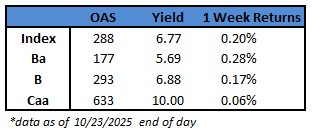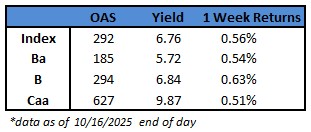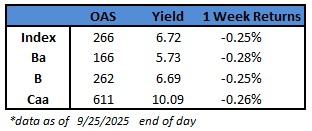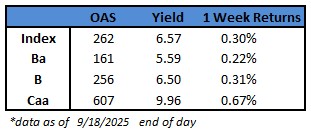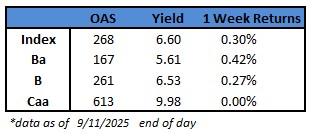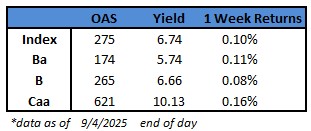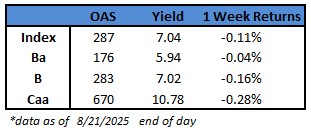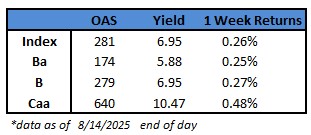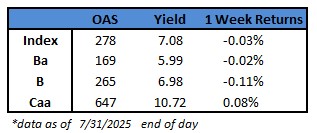(Bloomberg) High Yield Market Highlights
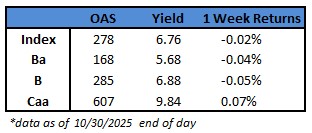
- US junk bonds tumbled, posting their steepest one-day loss in three weeks, as the risk premium climbed to 278 basis points after Chair Powell cautioned that a December rate cut is not a foregone conclusion. Yields rose 11 basis points to 6.76%, the biggest one-day jump in three weeks.
- The losses spanned across ratings. CCC yields, the riskiest tier of the high yield market, climbed 14 basis points to 9.84%. Spreads rose 14 basis points to 607 — the biggest one-day widening in three weeks.
- BB yields rose to 5.68% and spreads widened to 168
- The primary market ground to a halt after pricing a modest $4b this week and driving the October tally to about $18b, the slowest month for supply since April
(Bloomberg) Logan Joins Schmid in Opposing Fed Rate Cut, Citing Inflation
- Two Federal Reserve officials said they did not support the US central bank’s decision to cut interest rates this week, citing inflation that remains too high.
- Dallas Fed President Lorie Logan said she “did not see a need to cut rates this week” in remarks Friday prepared for an event in Dallas. Her comments followed a statement earlier in the day from her Kansas City counterpart, Jeff Schmid, outlining the reasons for his dissent against Wednesday’s rate cut.
- The remarks from Logan and Schmid were the first salvo in what is likely to be an intense debate over the next six weeks before the central bank’s next policy meeting in December, between officials who see a need for more easing to support the labor market and those who are more concerned about inflation.
- “I’d find it difficult to cut rates again in December unless there is clear evidence that inflation will fall faster than expected or that the labor market will cool more rapidly,” Logan said.
- Fed officials cut their benchmark rate this week by a quarter percentage point for a second month in a row after a sharp slowdown in hiring over the summer raised concerns about the labor market. Chair Jerome Powell, speaking to reporters Wednesday after the decision, said another cut in December was not a forgone conclusion, noting that some of his colleagues were concerned about inflation.
- That led to a sharp adjustment in the bond market, where investors had been pricing in near certainty of another quarter-point cut in December.
- While Logan doesn’t vote on monetary policy this year, she participates in Federal Open Market Committee discussions and will rotate onto the voting panel in 2026. Two Fed officials voted against the decision at this month’s meeting, with Schmid preferring to hold rates steady and Governor Stephen Miran dissenting for a second straight meeting in favor of a larger, half-point cut.
- “By my assessment, the labor market is largely in balance, the economy shows continued momentum, and inflation remains too high,” Schmid said in his statement.
This information is intended solely to report on investment strategies identified by Cincinnati Asset Management. Opinions and estimates offered constitute our judgment and are subject to change without notice, as are statements of financial market trends, which are based on current market conditions. This material is not intended as an offer or solicitation to buy, hold or sell any financial instrument. Fixed income securities may be sensitive to prevailing interest rates. When rates rise the value generally declines. Past performance is not a guarantee of future results.
